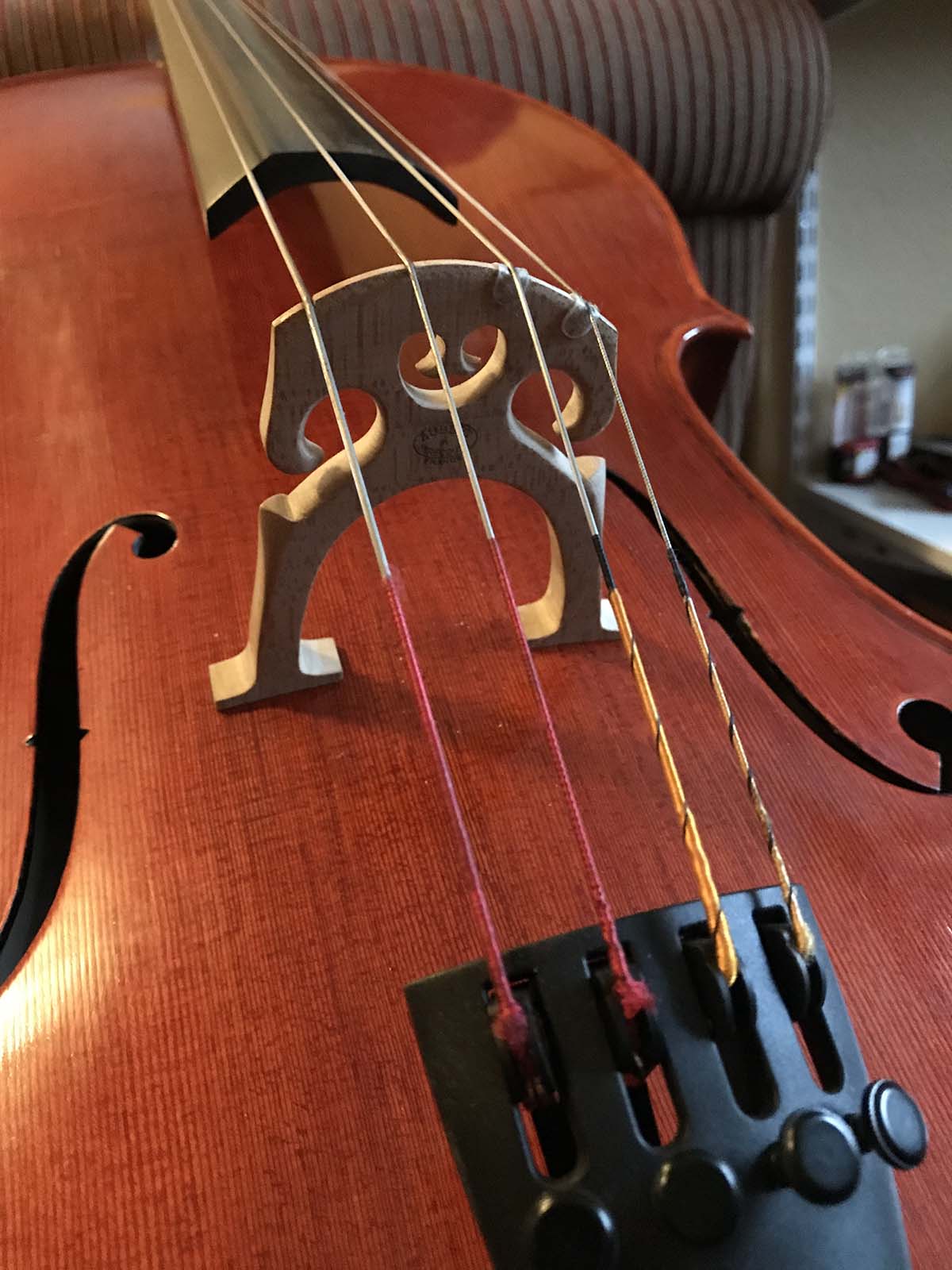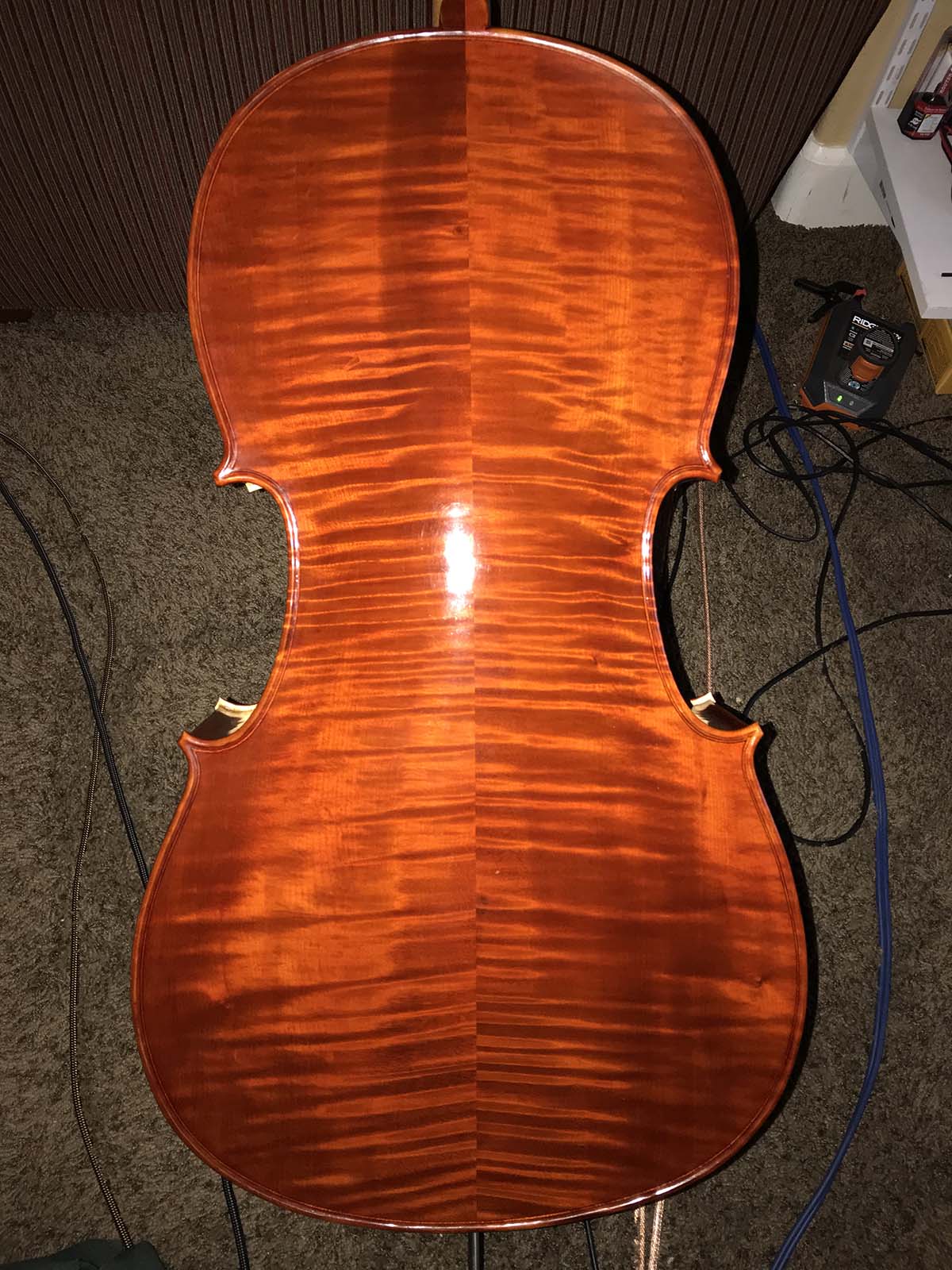Refinishing a Cello with a Polymerized Tung Oil Ground Coat
By
Steve Getsiv,
04/28/20
Over the Winter, I did a complete rebuild on my cello which I originally purchased on craigslist for $250 in June of 2019. I'm an engineer by education and have been taking things apart and putting them back together my whole life.
After doing an initial set up, I wasn't happy with the sound, especially the D string which was kind of muffled and not open sounding. I started with carving a new bridge, and have since carved 4 more, always trying to improve my skills. I tried different sound post positions taking notes about how it affected the sound. I then researched fingerboard undercutting and tap toning of the fingerboard itself - I finally got up enough courage to pull the fingerboard and relieve the back side - originally it was very rough, carved by a team of beavers, most likely.

The instrument got better and better as I did this work but still wasn't even as good as some of the shop German cellos I played in local Portland shops. It became obvious to me that the plates were way too thick so I took a deep dive at
platetuning.org and read every article I could find. After taking the instrument apart twice, I eventually came to realize that "free plate tuning" is not the final answer but fixed plate tuning (I ended up building a jig for the belly to hold the edges in place), worked really well and helped my focus on thinning the areas that needed attention. After my second regraduation session, the cello really started to sound great - better than anything I could find in shops up to $20K.
Fixed Plate Tuning of Cello on Subwoofer Shaker Table
I replaced the bass bar as well - ended up using a reverse triangle, Christian Bayon style, without the cut outs between the bass bar and the belly. I'm well aware of how resonance / stiffness works - the more weight away from the fulcrum, the lower the resonance frequency, and the stiffer the material at or near the fulcrum, the higher the resonance frequency - so it's therefore possible to both raise or lower the natural frequency of a fingerboard.
Anyway, I digress. Nothing I mentioned above is all that interesting and certainly not unique in the world of violin making other than tuning plates with jigs which doesn't seem to get enough recognition. I'm mainly posting because I decided to remove all that nasty sprayed on finish and recoat the instrument with what I think is likely a unique approach, at least not one that I have read about yet.
Several years ago, in partnership with a Portland, OR based manufacturer of specialty coatings, we designed a wood finish for exterior decking and siding - usable on both hardwoods and softwoods. We wanted to create something that would outlast all the Linseed Oil / Vegetable Oil based coatings that do not perform well in exterior conditions. We use only Pure Tung Oil from China, in a mix of polymerized and unpolymerized (we add some accelerators to the mix to help the overall finish dry quicker); then we add UV blockers, a fungicide, transparent iron oxides and just enough low VOC solvent to help it penetrate. It's technically a phenolic resin not an alkyd resin. We make this stuff in clear as well as 6 different colors.

After reading about ground coats and how it can affect the sound of the instrument, I decided to give our Tung oil formula a try. I laid down a couple thin layers of clear on the entire instrument and then laid down a couple thin layers of a 50/50 blend of Mahogany and Walnut with a little added transparent dye from Rockler - I used the TransTint brand. I lightly wet sanded between all coats. The finish dries quickly - within 12 hours in 80-90 degree heat; remember it's made from polymerized Tung oil and has added drying accelerators.
The products used for finishing included ExoShield Clear for base coat and then a mix of ExoShield Mahogany and Walnut before French polishing. These products are available in quart and half pint sizes at
Nova USA Wood.com's ExoShield page.
During my initial testing, I was absolutely blown away by how much more beautiful my cello sounded. Gorgeous overtones, no harshness, long ring time. After a few weeks of drying time, I finished the instrument with a French polish which brightened up the tone even more. This was all completed in February and March of 2020.
It sure has been great to have a hobby during the Corona virus lockdown. I am consistenly playing a couple hours per day. I've even made a few further improvements to the instrument recently. Stay tuned for updates!
Originally posted on Maestronet as
Ground Coat - Testing a Modern Finish.
By
Steve Getsiv,
04/28/20
"Can I communicate with Steve re the cello rebuild project? I am similarly afflicted (engineer with a cello project..) and I have a few questions. Get me at jack.cp.denison@gmail.com Thank you!"
By Jack on
04/22/21
"Hello friend. As an engineer you have to understand, that wood have different strength across and along the grains.
It is quite a huge difference, to be honest. Particularly in the spruce wood, where it can reach 9:1. It can be greatly reduced by the varnish, because varnish is "sticking" the lines in the wood together. It depends on the quality of the varnish, it's composition, thickness and how deep you allow to penetrate it into the wood. The goal is to make varnish thin, flexible but still strong enough to resist the wear AND to increase the natural ratio of the strenght perpetual to lines in the wood in CONTROLLED manner, somewhere to 7:1 ratio which gives you rounded, but still penetrating and projecting sound on the finest instruments. I'm a bit sceptical about "improvements" you did. If you had an instrument with weak tone, it could be tuned proper way. But you thined the whole plates, enhancing bass register, which was inevetably done by sacrificing of "fine" wooden texture in the sound and projection capability on higher registers. You didn't wanted to enhance vibrations by taking wooden material away, you wanted to do it by tuning the whole instrument so the frequencies are boosting each other in positive way, not killing each other. Because your instrument lacked the quality in upper register after hollowing the plates, you "enhanced ringing" by sticking the whole plate together with thick "plastic" coat penetrating deep inside the wood... i think this can be interesting project for hobby maker but for trained violinmaker it sounds a bit horrific. You should give that cello to professional player and try it in the large hall, comparing it to fine instrument to understand the difference you made..., and they can't be undone, I'm afraid. I'm sorry if it sounds too harsh, but I must warn anybody about trying this project at home."
By name on
02/13/24
"I have a cello that I believe that has been so lightly varnished because even a light finger nail scratch shows up and if I hadn’t asked my local luthier to coverup the scratches, it would have looked like cats walked all over it and sharped their nail on it!! Should I have my cello refinished?"
By Monica on
08/04/24
Comments?
Display Name:
Contact Email:
please be respectful of others' opinions and do not use profanity.
comments may be edited for objectionable content.
Email addresses are not publicly posted, and are used to follow up directly with your comment as needed.




























